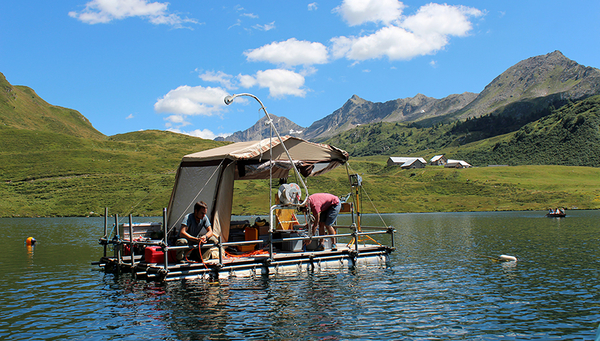Archive detail
Lake mixing – the might of the microorganism
October 5, 2017 |
Can microorganisms cause lake water to be mixed? The answer given by previous studies is no, since the movement of small, slow-swimming bacteria is not sufficient to disturb the stratification of lake water induced by differences in, for example, temperature or salinity.
A new study now shows that microorganisms can indeed cause the mixing of relatively thick water layers, not directly – by propulsion – but indirectly: if large numbers of small organisms which are denser than water accumulate locally, the density of the water is increased and the heavier water sinks, carrying the organisms with it. This leads to the mixing of water masses, with chemical and physical exchanges. Active upward swimming is required to maintain this mixing process, which the researchers call “bioconvection”.
The international research group led by Eawag demonstrated the occurrence of bioconvection, for the first time, not only in laboratory experiments, but in Lake Cadagno (canton of Ticino). Here, bacteria of the species Chromatium okenii are capable of mixing water layers with a thickness of up to 2 metres. The bacteria are found particularly in anoxic waters, forming a thick layer at a depth of around 12 metres in Lake Cadagno. In this layer, using automated methods developed for microbiological water monitoring, the scientists observed over ten thousand of the flagellate organisms per millilitre (i.e. more than ten billion per cubic meter). The bacteria swim upwards towards the light, but only as far as the interface between oxic and anoxic waters. The bacterial cells accumulating below this boundary increase the density of the water by a few per mille. This is sufficient to cause the heavier water to sink, initiating the mixing process (see graphics). As a result, during the summer months, parameters such as temperature or salinity at a depth of around 11–13 metres are found to be homogeneous, rather than steadily decreasing or increasing with depth as expected.
For first author Tobias Sommer, an environmental scientist, the results of the study are intriguing: “As well as the species we investigated, many other organisms are capable of driving bioconvection. So this phenomenon – previously underrated – is presumably common and relevant to lake and ocean ecology, for example in the case of algal blooms.”
Original publication
Sommer, T., et al. (2017), Bacteria induced mixing in natural waters, Geophys. Res. Lett., 44,
https:\\dx.doi.org\10.1002/2017GL074868;
The following institutions participated in the study: Eawag, SUPSI Bellinzona, ETH Zurich, EPF Lausanne, MPI Bremen, University of Iowa (US), Middle East Technical University Ankara (Turkey). The work was financed by Eawag, the ENAC Professors Visiting Program at EPFL, and the SNSF.
Graphics/photos
Temperature and salinity profiles at a depth of 11–14 metres in Lake Cadagno. The nearly uniform mixed layer is clearly visible at a depth of around 12.5 metres.
The computer simulation shows how a mixed layer emerges. Initially, concentrations of Chromatium okenii are evenly distributed within a layer (moderate concentration = green). The bacteria then swim upwards, accumulating at the top of the layer (below the dotted white line, simulation the oxygen level in Lake Cadagno; concentration doubled = red). As a result of the increased density, the heavier water sinks, creating circular currents.





